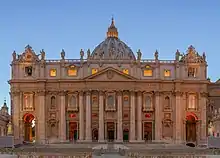Catholic liturgy
In the Catholic Church, liturgy is divine worship, the proclamation of the Gospel, and active charity.[1] Catholic liturgies are broadly categorized as the Latin liturgical rites of the Latin Church and the Eastern Catholic liturgies of the Eastern Catholic Churches.
| Part of a series on the |
| Catholic Church |
|---|
 |
| Overview |
|
|
Liturgical principles
As explained in greater detail in the Catechism of the Catholic Church:[2]
Liturgy is an "action" of the whole Christ (Christus totus). Those who even now celebrate it without signs are already in the heavenly liturgy, where celebration is wholly communion and feast
Sacraments
Sacraments in the Catholic Church are efficacious signs, perceptible to the senses, of grace.
The effect of the sacraments comes ex opere operato (by the very fact of being administered).
There are seven sacraments:[3]
- Baptism
- Eucharist
- Confirmation
- Penance, also called Confession and Reconciliation
- Anointing of the Sick, formerly called Extreme Unction and Last Sacraments
- Holy Orders
- Matrimony
Liturgical music
The 1967 document Musicam sacram, that implemented the Constitution on the Sacred Liturgy after the Second Vatican Council, repeatedly mentions facilitating the full, active participation of the congregation as called for by the Council.[4][5] so that "unity of hearts is more profoundly achieved by the union of voices".[6] Musicam Sacram states: "One cannot find anything more religious and more joyful in sacred celebrations than a whole congregation expressing its faith and devotion in song. Therefore the active participation of the whole people, which is shown in singing, is to be carefully promoted."[7] It calls for fostering this congregational participation through attention to choice of song directors,[8] to choice of songs,[9] and to the nature of the congregation.[10] It mentions the duty to achieve this participation on the part of choirs, choirs directors, pastors, organists, and instrumentalists.[11]
To achieve full, active participation of the congregation, great restraint in introducing new hymns has proven most helpful.[12] To this end also, the General Instruction of the Roman Missal recommends use of seasonal responsorial psalms and also keeping to a song that all can sing while processing to Communion, to "express the communicants' union in spirit by means of the unity of their voices, to show joy of heart, and to highlight more clearly the 'communitarian' nature of the procession to receive Communion."[13]
Devotional life of the Church
In its devotion the Church makes a distinction between respectful veneration on one hand and adoration or worship on the other. Adoration is due to God alone - this includes the Eucharist, since Christ is truly present. Veneration of an image or relic of a saint is defined as respect paid to what is represented in the image, not the image itself.[14]
Sacred space
"The mystery of Christ is so unfathomably rich that it cannot be exhausted by its expression in any single liturgical tradition. The history of the blossoming and development of these rites witnesses to a remarkable complementarity. When the Churches lived their respective liturgical traditions in the communion of the faith and the sacraments of the faith, they enriched one another and grew in fidelity to Tradition and to the common mission of the whole Church."[16]
"In the liturgy, above all that of the sacraments, there is an immutable part, a part that is divinely instituted and of which the Church is the guardian, and parts that can be changed, which the Church has the power, and on occasion the duty, to adapt to the cultures of recently evangelized peoples."[17]
Personal prayer
Likewise, the great variety of Catholic spirituality enables individual Catholics to pray privately in many different ways. The fourth and last part of the Catechism thus summarized the Catholic's response to the mystery of faith: "This mystery, then, requires that the faithful believe in it, that they celebrate it, and that they live from it in a vital and personal relationship with the living and true God. This relationship is prayer."[18]
References
- Catechism of the Catholic Church 1070 In the New Testament the word "liturgy" refers not only to the celebration of divine worship but also to the proclamation of the Gospel and to active charity.
- "CCC, 1136". Vatican.va.
- "CCC, 1210". Vatican.va.
- "Sacrosanctum concilium (114)". Retrieved 2019-09-25.
- "Musicam sacram (15)". Retrieved 2019-09-25.
- "Musicam sacram (5)". Retrieved 2019-09-25.
- "Musicam (16)". Retrieved 2019-09-25.
- "Musicam sacram (5)". Retrieved 2019-09-25.
- "Musicam sacram (9)". Retrieved 2019-09-25.
- "Musicam sacram (10)". Retrieved 2019-09-25.
- "Musicam sacram (19-20, 67)". Retrieved 2019-09-25.
- "How to get more people to sing at Mass: Stop adding new hymns". America Magazine. 2019-05-08. Retrieved 2019-09-25.
- "General Instruction of the Roman Missal (61, 86)". www.vatican.va. Retrieved 2019-09-25.
- "CCC, 2132". Vatican.va.
- "CCC, 1169". Vatican.va.
- "CCC, 1201". Vatican.va.
- "CCC, 1205". Vatican.va.
- "CCC, 2558". Vatican.va.

